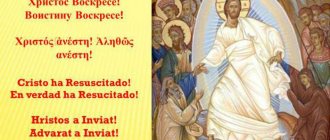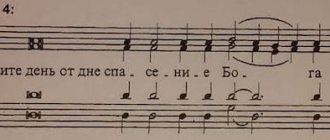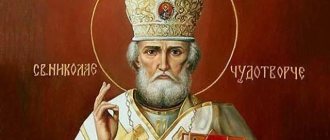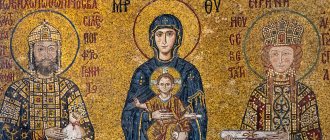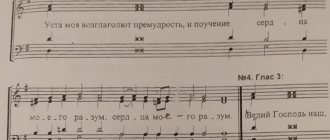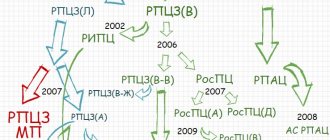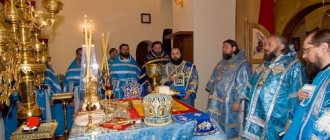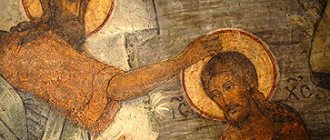When to read the Akathist
Prayer comes in different forms, first of all - church prayer, it is the most important, since all the church Sacraments are performed in the church, giving salvation to the soul. But there is also a home or cell room. At home, many believers like to read various akathists. What it is? This is a type of church poetry. If the name is translated from Greek, it indicates that you cannot sit while saying these prayers (for example, while reading kathisma, you can).
There are no church instructions on when it is necessary to turn to akathists. Every believer is free to read them according to the desire of his own soul. Usually they read one per week, or even daily - if you have enough spiritual strength. As a rule, they resort to this form of prayer when they want to pray for something serious:
- during illness;
- if you want to find a groom or conceive a child;
- when the wife wants her husband to stop drinking;
- about ending wars;
- They also ask for household needs.
What is reading akathists by agreement? It's very simple - people agree to read the same text at the same time. It so happens that, being in different places, they simultaneously offer their petitions to the Lord. The effect of such a reading will be much stronger than from a single one.
Features of the ministry
Akathist is a type of chant of praise
, addressed to Christ, the Mother of God or a specific saint. Translated from Greek, this word means “unsaddled song”: it must be performed and listened to while standing. The exception is pregnant women and infirm people; they are allowed to sit while reading.
The reading of the akathist can take place not only in church during a service. Any believer can do this at home, and as often as the soul requires. Some people like to read every day, others once a month - there are no restrictions. Except for one thing: a song of praise cannot be offered during Lent, when believers pray exclusively for the atonement of sins.
The Akathist is read while facing the icon of the saint or holiday in honor of which it was invented. When offering prayer at home, if the required icon is not available, you can stand facing east. Before reading it for the first time at home, it is better to listen in church
what the piece sounds like. It will become clear what intonation and tempo should be, how to pronounce words correctly and where to put emphasis in them.
Some believers practice reading akathists by agreement, when several people agree among themselves to read a certain text at the same time
. It is believed that the effect in this case is much stronger.
When akathists are read in church
Many people, being in the temple for the first time, reading the church schedule, do not understand everything. For example, what is a prayer service with an akathist? They are served on special days. For example, before the New Year, the start of school. Believers can independently order prayer services - before the start of an important task, before leaving, on name day. If desired, this rite can be combined with an akathist and the blessing of water.
Only according to canonical rules, such a service is not allowed immediately after the Liturgy, because it is a shortened version of the evening service. Therefore, you should not insist on your own if the priest appoints a different time. Prayer services can be served not only in the church - you can invite the priest to your home, to an event, to the field (to bless the future harvest). Only a clergyman is allowed to serve it, but akathists are read freely by the laity.
Kontakion today
Hymns composed in Orthodoxy according to the models of St. Romanus were of primary character until the 8th century. They were long, each with about 20-30 stanzas, separated by choruses. Performing them during services took a lot of time, which created some inconvenience. Therefore, from about the 8th century, the kontakion as a genre was replaced by the canon. However, this does not mean that hymns have ceased to be heard in cathedrals. They still performed the important function of glorifying and honoring the holiday for which they were written. There was just some modification of the genre. The meaning of the word “kontakion” in modern worship is as follows: these are 2 stanzas of solemn chant, performed together with ikos after the canons. The same term is used to refer to stanzas of akathists. Nowadays they usually sing the full kontakion only during funeral services for clergy. In other cases, they are limited to its truncated, shortened forms.
Akathist structure
This type of prayer represents an unchanging form. It contains 25 songs (13 kontakia and 12 ikos), which alternate with each other. The very first akathist was written around 626. Strictly speaking, only it is officially included in the liturgical charter. Dedicated to the Mother of God and is still widely circulated among believers.
Ikos, or stanzas, are divided into shorter verses, which contain 12 greetings each with the words “Rejoice!” In general, the hymn can be divided into 2 parts: the first tells a story about certain events (from the life of a saint or the history of a holiday). Next, a more complex part is the dogmatic one, which touches on the themes of salvation and the Incarnation. You can hear it in church once a year, during the Lenten period. In the church calendar it is called “Praise to the Mother of God.”
The genre developed rather slowly because it is quite complex. For example, the famous Akathist to the Sweetest Jesus dates back to the 13th century; it appeared in Slavic only in the 14th century. Authorship is attributed to Athonite monks. Today you can choose from a huge number, depending on your spiritual need.
What is an akathist, kontakion and troparion - when are they read, what are they needed for was last modified: July 7th, 2021 by Bogolub
Great article 0
Akathist - (translated from Greek - “non-seated singing”) - a prayer consisting of the 1st kontakion, which is sung, and 12 kontakia and ikos (equally divided), which are read. Thus, the akathists consist of 25 separate chants - 13 kontakia and 12 ikos. Of these, the 1st kontakion and all ikos end with the exclamation “Rejoice”..., and the 12th kontakion ends with the chorus “Alleluia”. The origin of the word “akathist” indicates that the designated chants are performed by those praying while standing. Kontakion - (translated from Greek - “house”) - a short song in praise of a saint or holiday. Ikos - (translated from Greek - house) - church chant containing the glorification of a saint or celebrated event. Ikos together with kontakia make up the akathist. Ikos and kontakion are similar in content and identical in presentation. The difference between them is that kontakion is shorter, and ikos is more extensive: kontakion is a theme, and ikos is its development. Therefore, the ikos is always read after the kontakion, and never read alone. According to Mark of Ephesus, ikos (from Greek “house”) got their name because they were sung in those houses where the saint spent his nights in prayer. Roman Sladkopevets, the first compiler of ikos. A canon is a combination of many sacred chants (irmos and troparia) into one harmonious composition (it acquired its current form in the 8th century, thanks to John of Damascus, the compiler of several canons for Sunday church services). The canon usually consists of 9 parts-songs, each containing 1 irmos and several troparia. Presenting either prosaic or poetic form, each canon in its content expresses the essence of the event being celebrated and its internal meaning. Canons can be complete (of 9 songs) and incomplete - consisting of one, two, three, four songs. In this case, the canon is written as follows: two songs, three songs, four songs. Troparion is a short song in which the deeds of God or His saints are glorified. This word in a broad sense means any church chant, even if it has a different, different name. In the closest sense, a troparion is a chant composed in honor of a holiday or saint. Irmos - (from the Greek “I bind”, “I unite”) - this is the name of the first troparion in a series of other troparions that make up one particular song of the canon. Irmos is the model according to which all other troparia of the same song are compiled, so that they all resemble Irmos in the number of sentences and words, the melody, and sometimes the content and very turns of speech, and therefore form one whole with it, for which Irmos serves as a connection. Knowing the melody of the Irmos, you can always correctly sing all the troparia that follow it; Therefore, the irmos is placed at the beginning of every song of the canon, so that other troparia that make up the song can be sung according to its example. In ancient times, the entire canon (i.e., both irmos and troparia) was sung; at present, this custom has been preserved only during the performance of the Easter canon; in all other canons, only irmos are sung, and troparia are read. The main thoughts and even expressions of the irmos were chosen for the most part from Old Testament songs, glorifying events that were prototypes of the events of the New Testament. Sedalen (Greek κάφισμα from the verb to sit) is a liturgical chant during which it is allowed to sit. In the ancient Church, during divine services, especially at Matins, after the psalms, which were sung standing, there were breaks for spiritual reflection on the sung psalms. During these reflections we sat. From such reflections arose chants called “sedals.” Subsequently, they began to sit while reading the psalms, and the name “kathisma” (that is, “sedalen”, “sedal”) was transferred to the psalms. In the Slavic Charter, the word “kathisma” is reserved for sections of the Psalter, and liturgical chants are called the Slavic word “sedalny”. “Sedalen, as the name itself shows, is a chant dedicated to the sitting of believers during its performance. And indeed, in monasteries, during the statutory performance of divine services, when it drags on for several hours, rest after a long period of standing is necessary. Therefore, sedals are such moments of rest for the brethren and worshipers. The exception, however, is the special sedalny, on which “we do not sit, at the priest’s holy altar, but I sing while standing.” These are the sedalnyas that are sung at Matins on Great Friday between the readings of the 12 Passionate Gospels. As a general rule, the sedalen is preceded by some edifying reading: from interpretations of the Holy Scriptures, lives of saints, Prologue, Lavsaik, etc. The sedalen is often performed after reading some “kathisma” of the Psalter. Why this name “sedalen” is explained - κάφισμα - in this way, the section of the Psalter, during the reading of which they sit, is called “kathisma”, and the chant, after such reading of the psalms and before reading from the holy fathers, is called “kathisma”, sedal.
Example: Troparion and Kontakion of the Annunciation
Troparion
(from the Greek τροπάριον -
tone, mode, melody
) - a short chant in which the essence of the holiday is revealed or the saint is glorified ().
Troparion is one of the oldest church hymns, with which Christianity began its development.
The troparion of the holiday reveals its essence and glorifies it. The troparion dedicated to the saint reveals the features of the saint’s feat, glorifies his life and holiness. Kontakion, chanting the same event or the same sacred person, complements and develops the main theme of the troparion. This can be clearly seen by comparing the troparion and kontakion of a particular holiday. Let us give an example of the troparion and kontakion of Easter: Troparion
:
Christ rose from the dead, trampling down death and giving life to those in the tombs. Kontakion
:
Even though you descended into the grave, Immortal, you destroyed the power of hell, and you rose again as the Victor, Christ God, to the myrrh-bearing women: Rejoice! Give peace to the table, give resurrection to the fallen.
Kondaks are also called individual prayer appeals containing a complete thought, of which it consists, and, in some cases, other short prayers.
“The vespers songs, increasing in their solemnity, end with the highest of all types of church chant - the troparion, the very name of which (τροπάριον, from τρόπος = ήχος, voice, melody) indicates the special complexity and richness of the melody for it. In each voice, the troparary melody constitutes the crown of all other chantings, of which only the prokeimenon can compete with it. Therefore, the troparion at all services occupies the most honorable place among other hymns, opening their series, as at Matins, completing it, as at Matins and Vespers, or replacing all other types of hymns, as at the Liturgy and at the Hours (at the latter, together with kontakion)".
“The origin of this word and, therefore, its true meaning is explained in different ways. The word τροπάριον comes from τροπαία, that is, “victorious sign”, trophy; in this case, its meaning is to glorify the victory of the martyr over paganism, the saint - over passions and the world, or the Savior Himself - over death. Another interpretation of this word puts it in connection with the “irmos” of the canon; if the irmos is the connection of song with song and, as it were, a model for the singing and melody of the troparary song, then the troparia turn to the irmos τέτραπται πρός τό. But, as Mirkovich correctly notes, this would be accurate if the troparia arose together with the canons, while the most ancient mentions of the troparia stand completely independent of the irmos and in general much earlier than the creation of the canons itself arose. In the 4th and 5th centuries, troparia already existed in Egypt and Asia Minor, while canons appeared only in the 8th century. Finally, the third explanation of this term makes it dependent on τρόπος, that is, pattern. Already among the ancient Hellenes, the method of singing, the “mode” in which it was sung, was called tropot. Ancient modes: Lydician, Mixolydian, Hypolydian, Phrygian, etc. were called "paths".
The oldest Christian mention of the troparion is found in the charter of the Great Church of Constantinople; this is the only chant of the ancient Byzantine service. A troparion is a chant not taken from Holy Scripture, therefore it is not a psalm or a biblical song.
In the modern charter, the word “troparion” is used often and in different meanings or, better, with different adjectives.
1. Troparions of dismissal
We must first distinguish between the so-called “dismissal” troparia, i.e. a short final hymn glorifying a given holiday, saint or appearance of an icon. This is actually a troparion in the real sense of the word.
2. Troparia of the canon
In addition, it talks about the troparia of the canon, that is, about the stanzas of Christian church songwriting that make up the songs of the canon, sung according to the model of the irmos and replenishing a certain number in a given song.
3. Troparia on “I cried to the Lord”
Sometimes the word “troparion” in the Typikon designates the stichera on “I cried to the Lord”; then it speaks of “I cried out to the troparia to the Lord.”
The troparia have their own deliberate melody in each voice. According to their content, troparia can also acquire some adjectives that characterize them, such as: Resurrected, Resurrection of the Cross, Theotokos, Martyrized, Theotokos, Pokoin, Trinity, Repentant, etc.”
Troparia are “the shortest hymns glorifying the main essence of the event. Although they differed from them in melody, they remained very close to them in poetic form and content: sedalny, luminary, ipakoi and even stichera. These latter, however, have their own melodies, but often even in books they are called “troparions to the Lord I cried.”
Theotokos
- hymns (stichera or troparion or sedalion) in honor of the Mother of God.
Voskresny
are hymns glorifying the glorious resurrection of Christ.
Mother of the Cross
- chants that depict the grief of the Mother of God over the death on the cross of Her Son and the true God.
They are sung on Wednesdays and Fridays instead of the Theotokos. Resurrection of the Cross
- chants in which the suffering of the cross and together the resurrection of the Lord are glorified.
In Oktoechos, on every Sunday after the Sunday canon, there is a canon of the cross. Dead and at rest
- containing prayers for the repose of the deceased.
They are placed in the Sabbath service (Octoeche) and in the rite of burial (mortal troparia for the immaculate). Martyrs
- songs in honor of the martyrs, contained in the Octoechos for all days of the week, except Sunday: at Matins - in the sedals, in the canons (except Thursday) and in the stichera on the stichera;
at Vespers - in stichera on stichera (on Saturday on “I cried to the Lord”); at the Liturgy - in the troparia for “blessed”. The martyrs are found in Octoechos and Triodion. In these books, before these hymns there is the inscription “martyr.” But the hymns of the Menaion, where entire services are held in honor of the martyrs, are not inscribed with this designation. Repentant (touching)
- the general theme of these chants is confession of sins before God, contrition for them and prayer for forgiveness.
They are laid out at the Monday and Tuesday services in the modified hymns of Octoechos. Three touching (or repentant) troparions are performed only during Great Lent (until the 5th week) and in the previous four weeks: “Open the doors of repentance, O Life-Giver...”, “Instruct me in the path of salvation, O Mother of God...” and “The many things I have done.” Thinking fiercely, the accursed one trembles at the terrible day of judgment...” Troparions for the Immaculates
- tell about the coming of the myrrh-bearing women to the tomb of the Savior, where they learned from the Angels about the miracle of His resurrection.
Performed at Polyeleos Matins. The 17th kathisma of the Psalter, consisting of one psalm 118, is called immaculate; It got its name from his first words: “ Blessed are the blameless
...”.
The Troparia for the Immaculates consists of six parts with choruses and glory. They begin with the refrain “Blessed are you, Lord,” separating the three subsequent parts of the troparion from one another. After the fourth part, “Glory” is read, after the fifth, “And Now.” They end with the singing of Hallelujah
. On holidays, instead of troparions “for the Immaculate Ones,” magnification is sung before the icon of the holiday. Troparions for the Immaculate are also sung at funeral services for bishops and honored priests.
When consecrating Easter cakes, Easter cakes, eggs, sprinkling them with holy water, the priest sings in the 2nd tone.
Newly converted Christians, and many unchurched Orthodox Christians, constantly hearing the words “akathist”, “kontakion”, “troparion”, simply accept them by ear, without thinking about the meaning and order of reading each of them.
In this article we will get acquainted with the genre of church chant - the troparion. Troparion in Orthodoxy is a chant performed at the beginning and end of the service, revealing the meaning and purpose of the service of that day.
Immaculate
“Troparia for the Immaculates” are hymns that recall how the myrrh-bearing women came to the tomb of the Lord and where they saw an angel and heard from him the happy news of his resurrection from the tomb. They are performed at Matins during the polyeleos.
The word “Immaculate” came into the Church Slavonic language from the 17th kathisma, which opens with the 118th psalm. “Blessed are the blameless on the way...” - this is what is sung in the psalm, and from this name the word “blameless” is strengthened. During the polyeleos, these troparia begin with the words “Blessed are you, Lord” and consist of six parts, each of which is separated by a chorus and exclamations: “Glory to the Father and the Son and the Holy Spirit” and “And now and ever and unto ages of ages. Amen".
On holidays, instead of the “Immaculate Ones,” the troparia “Magnificence” are sung before the icon. They are also performed when funeral services are held for bishops or priests who have earned the love of the people, their parish, and who have become martyrs.
One of the most famous troparions, which has become so widely famous that it has been translated into all languages, is the work “Quiet Light,” which is sung at the All-Night Vigil.
Church troparia, history of appearance and dedication
In the early Church, troparia, and these were musical comments on the ongoing divine service, were written not in poetry, but in prose in a certain rhythm. The poetic form of this type of chant appeared at the end of the fourth century.
Troparion is a song that speaks about the essence of the holiday
Over time, church hymnography was filled with several types of troparions dedicated to a specific day, holiday, or saint. The voice leads the church hymns. The words of the troparion reveal the essence of the service or glorify the name of some saint.
Kontakion is an extended troparion in which the main theme is revealed more fully. The troparion sounds in songs, and the kontakion is performed in poetic form. Hearing church hymns, one can determine by their meaning what event or saint the service is dedicated to.
Roman Sladkopevets acquired the right to be considered the first author of church hymns, having gone through humiliating trials. Being a deacon of the church in Greece, deprived of hearing and voice, the pious young man was under constant ridicule of his brothers, they more than once pushed him to lead the songs, and this was a shame and new mockery.
Roman expressed his grievances in his nightly prayers to the Mother of God, and one day the Mother of God appeared to him in his cell with a scroll. She ordered the deacon to eat the scroll, after this night the young man became not only the best church singer with a unique voice, but also received the gift of writing hymns.
Advice! If you want to learn to sing, pray to Roman the Sweet Singer. He is the author of the first Christmas troparion, which is still performed today.
The Charter of the Church of Constantinople contains the first troparia written by Roman the Sweet Singer.
Venerable Roman the Sweet Singer
The troparion and kontakion are performed once on each patronal feast, only on Easter the “Christ is Risen” is repeated three times.
Types of troparia
Songs of dismissal are the final songs dedicated to the holiday of the day.
Festive troparia and kontakia are performed on the twelve great holidays, including Christmas and Epiphany, Candlemas and Palm Sunday, and the year ends with the feast of the Entry of the Most Holy Theotokos into the Temple.
All chants, except the Liturgy, can be performed at home; they are also called verbal school.
They are sung according to the days of the week:
The notes and words of all church hymns are collected in the Troparion. The Holy Church clearly describes the hymns and order of each service.
The troparion is distinguished according to different topics, it can be:
- stichera – repetition of the text;
- kathisma - insertion between chants in the temple;
- Irmos - general singing, it is sung by everyone present in the temple.
Important!
The Church has established the order of hymns, the troparia are sung first, then the kontakia. On weekdays, temple chants are sung, which are also sung during Sunday services, if this day is not the day of remembrance of any saint.
Funeral Saturday hymns are performed when there is no glorification of the memory of the saint.
Sunday Troparions. Choir of the Metochion of the Alexander-Svirsky Monastery
What is the difference between kontakion and ikos?
Hieromonk Job (Gumerov) answers:
The word kontakion (Greek κόντάκιον) was first used to describe bundles of parchment with records of church chants; then - a short church song containing praise to the Lord God, the Mother of God or a saint. Sometimes a kontakion conveys the main content of a church holiday. Its name is associated with an event in the life of Saint Roman the Sweet Singer. He was from Syria and served as a deacon in Beirut. Under Emperor Anastasia I (491-518), he arrived in Constantinople, where over time he began to serve as a psalm-reader in the Cathedral of Hagia Sophia. At first he didn't stand out at all. The lack of success upset him greatly. He fervently prayed to the Most Holy Theotokos. Once, after such a prayer, he saw in a dream the Most Holy Theotokos, who handed him a scroll and ordered him to swallow it. Waking up and feeling inspired, he sang his famous kontakion for the feast of the Nativity of Christ: “Today a virgin gives birth to the Most Essential, and the earth brings a den to the Unapproachable; Angels and shepherds praise, while wolves travel with a star; For our sake, the Child of Mlado, the Eternal God, was born.”
Ikos (Greek o
ikos
- house) conveys the content of the kontakion in more detail. Kontakion outlines the theme, and ikos develops it. Ikos, unlike kontakion, contains a special refrain (refrain) and khayretisms (from the Greek rejoice) - greetings “Rejoice”, praising the one to whom the akathist is dedicated.
Introduction to Kontakia
Let's figure it out, kontakion - what is it? This was the name given in Greece, more precisely in the Byzantine Empire, to solemn hymns dedicated to the Mother of God, the feast of the Nativity of Christ, and various saints. Church songs were, as a rule, of sublime, pathetic content and glorified the clergyman in question. So, what is kontakion? A song of praise with religious content. It was created according to certain rules and had a strictly regulated form of execution. The first authors used the syllabic system of versification, achieving a clear rhythm in the poetic text to make it easier and more convenient to sing. The stanzas were supposed to contain teachings and instructions for the flock. They were pronounced from the pulpit by the priest. And the chorus (refrain) was sung by the choir of singers and the people present in the church.

